Work Session
Wednesday, November 3, 2021
9:00 a.m
Texas Parks and Wildlife Department
4200 Smith School Road
Austin, TX 78744
Arch “Beaver” Aplin, III, Commission Chair
Carter Smith, Executive Director
Approval of the Previous Minutes from the Commission Work Session held August 25, 2021
Approval of the Previous Minutes from the Commission Annual Public Hearing held August 25, 2021
Approval of the Previous Minutes from the Special Commission Work Session held September 15, 2021
- Update on the Texas Parks and Wildlife Department’s Progress in Implementing the Texas Parks and Wildlife Department Land and Water Resources Conservation and Recreation Plan – Carter Smith
- Internal Affairs Update
- Staff Recognition
- Red Drum Hatchery Fingerlings
- Law Enforcement Operations
- Fiscal Year 2021 Stocking Report
- Internal Audit Update – Brandy Meeks
- Designation of Nonprofit Partners – Recommended Adoption of Proposed Changes – Brittney Zepeda (Action Item No. 1)
- Coastal Thermal Refuge Area Closures – Recommended Adoption of Proposed Changes – Brian Bartram (Action Item No. 2)
- Digital Licensing and Tagging Requirements – Recommended Adoption of Proposed Changes – Robin Riechers (Action Item No. 3)
- Proposed Amendments to the Exotic Harmful or Potentially Harmful Fish, Shellfish, and Aquatic Plants Rules – Recommended Adoption of Proposed Changes – Monica McGarrity (Action Item No. 4)
- Implementation of Legislation during the 87th Texas Legislative Session – House Bill 1927 – Relating to Provisions Governing the Carrying of a Firearm – Request Permission to Publish in the Texas Register – Luis Sosa
- Chronic Wasting Disease - Disease Detection and Response – Recommended Adoption of Proposed Changes – Mitch Lockwood (Action Item No. 5)
- 2022-2023 Statewide Recreational and Commercial Fishing Proclamation Preview – Monica McGarrity, Dakus Geeslin
- 2022-2023 Statewide Hunting and Migratory Game Bird Proclamation Preview – Alan Cain, Shawn Gray, Shaun Oldenburger
- State Parklands Passport Rules – Request Permission to Publish in the Texas Register – David Kurtenbach
- Briefing – Diversity and Inclusion Goals – David Buggs
- Briefing – Cast Netting at Fayette County Reservoir – Craig Bonds
- Exchange of Land – Parker County – Approximately 12 Acres at Lake Mineral Wells State Park and Trailway – Request Permission to Begin the Public Notice and Input Process – Trey Vick (Work Session and Executive Session)
- Exchange of Easements – Somervell County – Approximately 0.1 Acre at Dinosaur Valley State Park – Request Permission to Begin the Public Notice and Input Process – Trey Vick (Work Session and Executive Session)
- Request for Drainage Easement – Orange County – Approximately 20 Acres at the Lower Neches Wildlife Management Area – Request Permission to Begin the Public Notice and Input Process – Ted Hollingsworth (Work Session and Executive Session)
- Litigation Update – James Murphy (Executive Session Only)
- Personnel Matters – Performance Evaluation of the Texas Parks and Wildlife Department Executive Director – Chairman Arch “Beaver” Aplin, III (Executive Session Only)
Land and Water Plan
Financial
Natural Resources
Land Conservation
Executive Session
Work Session Item No. 1
Presenter: Carter Smith
Work Session
Update on the Texas Parks and Wildlife Department’s Progress
in Implementing the Texas Parks and Wildlife Department Land and
Water Resources Conservation and Recreation Plan
November 3, 2021
I. Executive Summary: Executive Director Carter Smith will briefly update the Texas Parks and Wildlife Commission (Commission) on the status of Texas Parks and Wildlife Department’s (TPWD) efforts to implement the Land and Water Resources Conservation and Recreation Plan (plan).
II. Discussion: In 2001, the 77th Texas Legislature directed that TPWD develop a Land and Water Resources Conservation and Recreation Plan (Texas Parks and Wildlife Code section 11.104). In 2002, the Commission adopted the first plan. A revised plan was adopted by the Commission in January 2005. In November 2009, the Commission approved a new plan, effective January 1, 2010, that included broad input from stakeholders and the general public. Minor revisions continue to be made to the plan. The 2015 version of the plan is available on the TPWD website. Executive Director Carter Smith will update the Commission on TPWD’s recent progress in achieving the plan’s goals, objectives, and deliverables.
The plan consists of the following four goals:
- Practice, Encourage, and Enable Science-Based Stewardship of Natural and Cultural Resources
- Increase Access to and Participation in the Outdoors
- Educate, Inform, and Engage Texas Citizens in Support of Conservation and Recreation
- Employ Efficient, Sustainable, and Sound Business Practices
Work Session Item No. 2
Presenter: Brandy Meeks
Work Session
Internal Audit Update
November 3, 2021
I. Executive Summary: The staff will present an update on the Texas Parks and Wildlife Department (TPWD) Fiscal Year (FY) 2021 and 2022 Internal Audit Plans and ongoing or completed external audits.
II. Discussion: The staff will provide an update on the TPWD FY 2021 and 2022 Internal Audit Plans, as well as a briefing of any external audits that have been recently completed or are ongoing.
Work Session Item No. 7
Presenter: Luis Sosa
Work Session
Implementation of Legislation during the 87th Texas Legislative Session – House Bill 1927
Relating to Provisions Governing the Carrying of a Firearm
Request Permission to Publish in the Texas Register
November 3, 2021
I. Executive Summary: With this item staff requests permission to publish proposed amendments to rules governing the possession, display, and use of firearms on state parks, wildlife management areas, and coastal management areas in response to the passage of House Bill (H.B.) 1927 by the most recent regular session of the Texas Legislature.
II. Discussion: Under the provisions of H.B. 1927 (Regular Session, 2021), a person 21 years of age or older who is not otherwise prohibited by state or federal law from possessing a firearm may carry a handgun (provided it is concealed or in a holster) without a permit in any location where such possession is not expressly prohibited by statute or prohibited pursuant to statutory authority granted by statute. Under the provisions of H.B. 1927, the Texas Parks and Wildlife Commission does not have the authority to establish regulations to modify or prohibit the effect of the legislation. The proposed rules (located at Exhibits A, B, and C) comport existing Texas Parks and Wildlife Department regulations with the intent of the legislature.
Attachments – 3
Work Session Item No. 7
Exhibit A
STATE PARK OPERATIONAL RULES
RULES OF CONDUCT IN PARKS
PROPOSAL PREAMBLE
1. Introduction
The Texas Parks and Wildlife Department proposes amendments to 31 TAC §59.131 and §59.134, concerning State Park Operational Rules. The proposed amendments would comport department rules governing the possession and display of handguns by visitors to state parks with the provisions of legislation enacted in the most recent general session of the Texas Legislature. Under the provisions of House Bill 1927 (Regular Session, 2021), a person 21 years of age or older who is not otherwise prohibited by state or federal law from possessing a firearm may carry a handgun (provided it is concealed or in a holster) without a permit in any location where such possession is not expressly prohibited by statute or prohibited pursuant to statutory authority granted by statute. Under the provisions of H.B. 1927, the Texas Parks and Wildlife Commission does not have the authority to establish regulations to modify or prohibit the effect of the legislation.
The proposed amendment to §59.131, concerning Definitions, would modify the current definition of “arms and firearms” by adding the word “weapons” to provide emphasis and a reference to the definition of “firearm” in the Penal Code, to provide clarity as the applicability of department regulations to specific conduct regarding firearms.
The proposed amendment to §59.134, regarding Rules of Conduct in State Parks, would alter current rule to the effect of ensuring that department regulations regarding the possession and display of handguns in state parks do not conflict with the provisions of House Bill 1927. The proposed amendment would also add language to prohibit the brandishing of weapons, arms, and firearms, which is necessary to create a distinction between the legal display of handguns authorized by H.B. 1927 and other conduct that is disruptive or dangerous with respect to arms, weapons, and firearms. Additionally, the proposed amendment would alter current language regarding exceptions to the prohibition of display and use of arms, weapons, and firearms to clarify that the exceptions exist only during the authorized activities and not at any other time the person is within the park.
2. Fiscal Note.
Robert Macdonald, Regulations Coordinator, has determined that for each of the first five years that the rules as proposed are in effect, there will be no fiscal implications to state or local governments as a result of administering or enforcing the rules.
3. Public Benefit/Cost Note.
Mr. Macdonald also has determined that for each of the first five years that the rules as proposed are in effect:
(A) The public benefit anticipated as a result of enforcing or administering the proposed rules will be compliance with the will of the legislature.
(B) Under provisions of Government Code, Chapter 2006, a state agency must prepare an economic impact statement and a regulatory flexibility analysis for a rule that may have an adverse economic effect on small businesses and micro-businesses. Those guidelines state that an agency need only consider a proposed rule’s "direct adverse economic impacts" to small businesses and micro-businesses to determine if any further analysis is required. For that purpose, the department considers "direct economic impact" to mean a requirement that would directly impose recordkeeping or reporting requirements; impose taxes or fees; result in lost sales or profits; adversely affect market competition; or require the purchase or modification of equipment or services. The department has determined that because the proposed rules regulate conduct of visitors to state parks, there will be no direct effect on small businesses, micro-businesses, or rural communities. On this basis, the department has a determined that neither the economic impact statement nor the regulatory flexibility analysis described in Government Code, Chapter 2006, is required.
(C) The department has not drafted a local employment impact statement under the Administrative Procedures Act, §2001.022, as the agency has determined that the rules as proposed will not impact local economies.
(D) The department has determined that Government Code, §2001.0225 (Regulatory Analysis of Major Environmental Rules), does not apply to the proposed rules.
(E) The department has determined that there will not be a taking of private real property, as defined by Government Code, Chapter 2007, as a result of the proposed rules.
(F) In compliance with the requirements of Government Code, §2001.0221, the department has prepared the following Government Growth Impact Statement (GGIS). The rules as proposed, if adopted, will:
(1) neither create nor eliminate a government program;
(2) not result in an increase or decrease in the number of full-time equivalent employee needs;
(3) not result in a need for additional General Revenue funding;
(4) not affect the amount of any fee;
(5) not create a new regulation;
(6) not expand an existing regulation;
(7) neither increase nor decrease the number of individuals subject to regulation; and
(8) not positively or adversely affect the state’s economy.
4. Request for Public Comment.
Comments on the proposed rule may be submitted to Chief Wes Masur, Texas Parks and Wildlife Department, 4200 Smith School Road, Austin, Texas 78744; (512) 389-8001; email: wes.masur@tpwd.texas.gov or via the department website at www.tpwd.texas.gov.
5. Statutory Authority.
The amendments are proposed under Parks and Wildlife Code, §13.101, which provides the commission with authority to promulgate regulations governing abusive, disruptive, or destructive conduct of persons; the activities of park users including camping, swimming, boating, fishing, or other recreational activities; and conduct which endangers the health or safety of park users or their property.
The proposed amendments affect Parks and Wildlife Code, Chapter 13.
6. Rule Text.
§59.131. Definitions. The following words and terms, when used in this subchapter, shall have the following meanings, unless the context clearly indicates otherwise.
(1) Arms, weapons, and firearms — Any device from which shot, a projectile, arrow, or bolt is fired by the force of an explosion, compressed air, gas, or mechanical device. To include, but not limited to, any device described by Penal Code, §46.01(3), rifle, shotgun, handgun, air rifle, pellet gun, longbow, cross bow, sling shot, blow gun, or dart gun.
(2) – (20) (No change.)
§59.134. Rules of Conduct in Parks.
(a) – (c) (No change.)
(d) Arms, Weapons, and Firearms.
(1) It is an offense for any person to brandish a weapon, arms, or firearm in a state park. For the purposes of this subsection “to brandish” means to exhibit, flaunt, wield, or otherwise handle or employ a weapon, arm, or firearm in a manner that is threatening, menacing, or unsafe.
(2) It is an offense for any person to display or discharge a weapon, arms,[an arm] or firearm in a state park, except[unless]:
(A)[(1)] while lawfully hunting[the person is participating in a public hunting activity] within the state park as[that has been] authorized by [written order of the director so long as the person is in compliance with the] applicable public hunting rules and regulations.
(B)[(2)] while lawfully[the person is] fishing by means of lawful archery equipment or while[is] participating in an authorized, supervised recreational or educational activity; or
(C)[(3) the person is licensed to possess and carry a handgun under Government Code, Chapter 411, Subchapter H and in possession of and/or carrying the handgun in compliance with applicable law, including, but not limited to, applicable regulations adopted pursuant to Government Code, Chapter 411, Subchapter H; or]
[(4)] the person has been authorized to do so by written order of the director.
(3) A person may possess a handgun in a state park in accordance with applicable law, including, but not limited to, the provisions of Penal Code, Chapter 46, and Government Code, Chapter 411, Subchapter H.
(e) – (q) (No change.)
This agency hereby certifies that the proposal has been reviewed by legal counsel and found to be within the agency’s authority to adopt.
Issued in Austin, Texas, on
Work Session Item No. 7
Exhibit B
PUBLIC HUNTING PROCLAMATION
PROPOSAL PREAMBLE
1. Introduction
The Texas Parks and Wildlife Department proposes amendments to 31 TAC §§65.199, 65.202, and 65.203, concerning the Public Hunting Proclamation. The proposed amendments would comport department rules governing the possession and display of handguns on wildlife management areas operated by the department with the provisions of legislation enacted in the most recent general session of the Texas Legislature. Under the provisions of House Bill 1927 (Regular Session, 2021), a person 21 years of age or older who is not otherwise prohibited by state or federal law from possessing a firearm may carry a handgun (provided it is concealed or in a holster) without a permit in any location where such possession is not expressly prohibited by statute or prohibited pursuant to statutory authority granted by statute. Under the provisions of H.B. 1927, the Texas Parks and Wildlife Commission does not have the authority to establish regulations to modify or prohibit the effect of the legislation.
The proposed amendment to §65.199, concerning General Rules of Conduct, §65.201, concerning Motor Vehicles, and §65.203, concerning Hunter Safety, would create exceptions to current rules regarding possession of firearms to allow persons to possess a handgun in compliance with applicable law, including, but not limited to, Penal Code, Chapter 46 and Government Code, Chapter 11, Subchapter H. The proposed amendment to §65.203 would also make nonsubstantive changes to enhance clarity.
2. Fiscal Note.
Robert Macdonald, Regulations Coordinator, has determined that for each of the first five years that the rules as proposed are in effect, there will be no fiscal implications to state or local governments as a result of administering or enforcing the rules.
3. Public Benefit/Cost Note.
Mr. Macdonald also has determined that for each of the first five years that the rules as proposed are in effect:
(A) The public benefit anticipated as a result of enforcing or administering the proposed rules will be compliance with the will of the legislature.
(B) Under provisions of Government Code, Chapter 2006, a state agency must prepare an economic impact statement and a regulatory flexibility analysis for a rule that may have an adverse economic effect on small businesses and micro-businesses. Those guidelines state that an agency need only consider a proposed rule’s "direct adverse economic impacts" to small businesses and micro-businesses to determine if any further analysis is required. For that purpose, the department considers "direct economic impact" to mean a requirement that would directly impose recordkeeping or reporting requirements; impose taxes or fees; result in lost sales or profits; adversely affect market competition; or require the purchase or modification of equipment or services. The department has determined that because the proposed rules regulate conduct of visitors to state parks, there will be no direct effect on small businesses, micro-businesses, or rural communities. On this basis, the department has a determined that neither the economic impact statement nor the regulatory flexibility analysis described in Government Code, Chapter 2006, is required.
(C) The department has not drafted a local employment impact statement under the Administrative Procedures Act, §2001.022, as the agency has determined that the rules as proposed will not impact local economies.
(D) The department has determined that Government Code, §2001.0225 (Regulatory Analysis of Major Environmental Rules), does not apply to the proposed rules.
(E) The department has determined that there will not be a taking of private real property, as defined by Government Code, Chapter 2007, as a result of the proposed rules.
(F) In compliance with the requirements of Government Code, §2001.0221, the department has prepared the following Government Growth Impact Statement (GGIS). The rules as proposed, if adopted, will:
(1) neither create nor eliminate a government program;
(2) not result in an increase or decrease in the number of full-time equivalent employee needs;
(3) not result in a need for additional General Revenue funding;
(4) not affect the amount of any fee;
(5) not create a new regulation;
(6) not expand an existing regulation;
(7) neither increase nor decrease the number of individuals subject to regulation; and
(8) not positively or adversely affect the state’s economy.
4. Request for Public Comment.
Comments on the proposed rule may be submitted to Chief Wes Masur, Texas Parks and Wildlife Department, 4200 Smith School Road, Austin, Texas 78744; (512) 389-8001; email: wes.masur@tpwd.texas.gov or via the department website at www.tpwd.texas.gov.
5. Statutory Authority.
The amendments are proposed under Parks and Wildlife Code, §81.403, which allows the department to issue permits authorizing access to public hunting land or for specific hunting, fishing, recreational, or other use of public hunting land or a wildlife management area and requires the commission to prescribe by rule the conditions for the issuance and use of such permits, and §81.405, which provides the commission with authority to adopt rules governing recreational activities in wildlife management areas.
The proposed amendments affect Parks and Wildlife Code, Chapter 81.
6. Rule Text.
§65.199. General Rules of Conduct.
(a) – (b) (No changes.)
(c) It is unlawful for any person to:
(1) (No change.)
(2) possess a firearm, archery equipment, arrow gun, air gun, or any other device for taking wildlife resources on public hunting lands, except for persons authorized by the department to hunt or conduct research on the area, commissioned law enforcement officers, and department employees in performance of their duties; provided, however, a person may possess a handgun in compliance with applicable law, including, but not limited to, the provisions of Penal Code, Chapter 46, and Government Code, Chapter 411, Subchapter H.
(3) – (19) (No change.)
(d) (No change.)
§65.201. Motor Vehicles.
(a) (No change.)
(b) It is unlawful for any person to:
(1) hunt any wildlife resource from a motor vehicle or[,] motor-driven land conveyance[, or possess a loaded firearm, arrow gun, or air gun in or on the vehicle,] except
as provided for a disabled person; or
(2) possess a loaded firearm, arrow gun, or air gun in or on a motor vehicle or motor-driven land conveyance, except that a person may possess a handgun in accordance with applicable law, including, but not limited to, the provisions of Penal Code, Chapter 46, and Government Code, Chapter 411, Subchapter H.
(c) – (e) (No change.)
§65.203. Hunter Safety.
(a) – (b) (No change.)
(c) Except as provided in subsection (d) of this section, it[It] is an offense to:
(1) possess a loaded firearm, arrow gun, or air gun in or on a motor vehicle, except as provided in §65.201(c) of this title (relating to Motor Vehicles) for a disabled person; or[.]
(2)[(d) It is an offense to] possess a loaded firearm, arrow gun, or air gun within a designated campsite, vehicle parking area, boat launching facility, or departmental check station.
(d) The provisions of subsection (c) of this section do not apply to a person in possession of a handgun in compliance with applicable law, including, but not limited to, Penal Code, Chapter 46, and Government Code, Chapter 411, Subchapter H.
(e) – (f) (No change.)
This agency hereby certifies that the proposal has been reviewed by legal counsel and found to be within the agency’s authority to adopt.
Issued in Austin, Texas, on
Work Session Item No. 7
Exhibit C
COASTAL MANAGEMENT AREAS
PROPOSAL PREAMBLE
1. Introduction
The Texas Parks and Wildlife Department proposes amendments to 31 TAC §57.1011 and §57.1012, concerning Coastal Management Areas. The proposed amendments would comport department rules governing the possession and display of handguns on coastal management areas (CMAs) operated by the department with the provisions of legislation enacted in the most recent general session of the Texas Legislature. Under the provisions of House Bill 1927 (Regular Session, 2021), a person 21 years of age or older who is not otherwise prohibited by state or federal law from possessing a firearm may carry a handgun (provided it is concealed or in a holster) without a permit in any location where such possession is not expressly prohibited by statute or prohibited pursuant to statutory authority granted by statute. Under the provisions of H.B. 1927, the Texas Parks and Wildlife Commission does not have the authority to establish regulations to modify or prohibit the effect of the legislation.
The proposed amendment to §57.1011, concerning Definitions, would insert the word “weapons” into the definition in paragraph (2) for emphasis, and a reference to the Penal Code definition of firearms, for clarity.
The proposed amendment to §57.1012, concerning Rules of Conduct, would create an exception to the current rule regarding display of handguns to allow persons to possess a handgun in compliance with applicable law, including, but not limited to, applicable regulations adopted pursuant to Government Code, Chapter 411, Subchapter H and Penal Code, Chapter 46. The proposed amendment would also add language to prohibit the brandishing of weapons, arms, and firearms, which is necessary to create a distinction between the legal display of handguns authorized by H.B. 1927 and other conduct that is disruptive or dangerous with respect to arms, weapons, and firearms.
2. Fiscal Note.
Robert Macdonald, Regulations Coordinator, has determined that for each of the first five years that the rules as proposed are in effect, there will be no fiscal implications to state or local governments as a result of administering or enforcing the rules.
3. Public Benefit/Cost Note.
Mr. Macdonald also has determined that for each of the first five years that the rules as proposed are in effect:
(A) The public benefit anticipated as a result of enforcing or administering the proposed rules will be compliance with the will of the legislature.
(B) Under provisions of Government Code, Chapter 2006, a state agency must prepare an economic impact statement and a regulatory flexibility analysis for a rule that may have an adverse economic effect on small businesses and micro-businesses. Those guidelines state that an agency need only consider a proposed rule’s "direct adverse economic impacts" to small businesses and micro-businesses to determine if any further analysis is required. For that purpose, the department considers "direct economic impact" to mean a requirement that would directly impose recordkeeping or reporting requirements; impose taxes or fees; result in lost sales or profits; adversely affect market competition; or require the purchase or modification of equipment or services. The department has determined that because the proposed rules regulate conduct of visitors to state parks, there will be no direct effect on small businesses, micro-businesses, or rural communities. On this basis, the department has a determined that neither the economic impact statement nor the regulatory flexibility analysis described in Government Code, Chapter 2006, is required.
(C) The department has not drafted a local employment impact statement under the Administrative Procedures Act, §2001.022, as the agency has determined that the rules as proposed will not impact local economies.
(D) The department has determined that Government Code, §2001.0225 (Regulatory Analysis of Major Environmental Rules), does not apply to the proposed rules.
(E) The department has determined that there will not be a taking of private real property, as defined by Government Code, Chapter 2007, as a result of the proposed rules.
(F) In compliance with the requirements of Government Code, §2001.0221, the department has prepared the following Government Growth Impact Statement (GGIS). The rules as proposed, if adopted, will:
(1) neither create nor eliminate a government program;
(2) not result in an increase or decrease in the number of full-time equivalent employee needs;
(3) not result in a need for additional General Revenue funding;
(4) not affect the amount of any fee;
(5) not create a new regulation;
(6) not expand an existing regulation;
(7) neither increase nor decrease the number of individuals subject to regulation; and
(8) not positively or adversely affect the state’s economy.
4. Request for Public Comment.
Comments on the proposed rule may be submitted to Chief Wes Masur, Texas Parks and Wildlife Department, 4200 Smith School Road, Austin, Texas 78744; (512) 389-8001; email: wes.masur@tpwd.texas.gov or via the department website at www.tpwd.texas.gov.
5. Statutory Authority.
The amendments are proposed under Parks and Wildlife Code, §81.006, which allows the department to authorize access to wildlife management areas (which includes coastal management areas) and §81.405, which provides the commission with authority to adopt rules governing recreational activities in wildlife management areas, including coastal management areas.
The proposed amendments affect Parks and Wildlife Code, Chapter 81.
6. Rule Text.
§57.1011. Definitions. The following words and terms, when used in this subchapter, shall have the following meanings, unless the context clearly indicates otherwise.
(1) (No change.)
(2) Arms, weapons, and firearms — Any device from which shot, a projectile, arrow, or bolt is fired by the force of an explosion, compressed air, gas, or mechanical device, including, but not limited to, any device described by Penal Code, §46.01(3), rifle, shotgun, handgun, air rifle, pellet gun, longbow, cross bow, sling shot, blow gun, or dart gun.
(3) – (7) (No change.)
§57.1012. Rules of Conduct.
(a) – (d) (No change.)
(e) Arms, Weapons, and Firearms.
(1) It is an offense for any person to brandish a weapon, arms, or firearm in a CMA. For the purposes of this subsection “to brandish” means to exhibit, flaunt, wield, or otherwise handle or employ a weapon, arm, or firearm in a manner that is threatening, menacing, or unsafe.
(2) It is an offense for any person to display or discharge arms, a weapon,[an arm] or firearm except:
(A)[(1)] while hunting migratory game birds under the provisions of this subchapter; or
(B)[(2)] while fishing by means of lawful archery equipment.
(3) A person may possess a handgun in a CMA in accordance with applicable law, including, but not limited to, the provisions of Penal Code, Chapter 46, and Government Code, Chapter 411, Subchapter H.
(f) – (o) (No change.)
This agency hereby certifies that the proposal has been reviewed by legal counsel and found to be within the agency’s authority to adopt.
Issued in Austin, Texas, on
Work Session Item No. 9
Presenters: Monica McGarrity
Dakus Geeslin
Work Session
2022-2023 Statewide Recreational and Commercial Fishing Proclamation Preview
November 3, 2021
I. Executive Summary: With this item, the staff seeks to apprise the Texas Parks and Wildlife Commission (Commission) of potential changes to recreational and commercial fishing regulations for the 2022-2023 season.
II. Discussion: Responsibility for establishing seasons, bag limits, and means and methods for taking freshwater and saltwater fisheries resources is delegated to the Commission under Texas Parks and Wildlife Code chapters 61 (Uniform Wildlife Regulatory Act), 66 (Fish), 67 (Nongame Species), 76 (Oysters), 77 (Shrimp), and 78 (Mussels, Clams, and Crabs). The potential changes are based upon statutory requirements and Commission policy, including scientific investigation and required findings of fact where applicable. The potential changes are intended to increase recreational opportunity, decrease regulatory complexity where possible, promote enforcement, and provide for the sound biological management of the fisheries resources of the state.
Attachment – 1
Work Session Item No. 9
Exhibit A
Potential Changes to Fisheries Regulations 2021-2022
Inland Fisheries
- Sam Rayburn Reservoir (Jasper County) — Delineate the upstream reservoir boundary for Sam Rayburn Reservoir to differentiate between the inflowing river and the reservoir where special exceptions to statewide catfish daily bag, possession, and length limits are in place.
- Bois d’Arc Lake (Fannin County) – Implement Largemouth Bass harvest regulations for soon to be opened Bois d’Arc Lake to establish a 16-inch maximum size limit and exceptions for temporary possession of 24-inch bass as potential ShareLunkers. The department has determined that initial preservation of the largest, fastest growing bass in a new reservoir is needed to help to maximize the quality of fishing over the lifespan of the reservoir.
- Lake Texoma (Cooke and Grayson counties) – Modify harvest regulations for walleye in Lake Texoma to eliminate special exceptions to statewide daily bag, possession, and length limits for walleye in Lake Texoma and return to statewide regulations. This species has not been stocked in the lake since 1977, a self-sustaining population was not established in the lake, and walleye are not managed as a sport fishery, and therefore special exceptions are no longer needed.
- Lake Texoma (Cooke and Grayson counties) – Modify harvest regulations for alligator gar in Lake Texoma to extend prohibition of harvest during the month of May from the portion of Lake Texoma encompassed within the boundaries of the Hagerman National Wildlife Refuge or that portion of Lake Texoma from the U.S. 377 bridge (Willis Bridge) upstream to the I.H. 35 bridge to apply to the entire lake. This amended special exception is commensurate with the reciprocal regulations in the corresponding Oklahoma portions of Lake Texoma that became effective in July 2021 and seeks to reduce enforcement issues arising from differences in regulations on either side of the reservoir.
- Lake Texoma (Cooke and Grayson counties) – Delineate the upstream reservoir boundary for Lake Texoma to differentiate between the Oklahoma waters of the inflowing river and the Texas waters of the reservoir where special exceptions to statewide daily bag, possession, and length limits are in place for several fish species and seek to ensure consistency with Oklahoma regulations.
- Coleto Creek Reservoir (Goliad and Victoria counties) and Fairfield Lake (Freestone County) – Modify harvest regulations for red drum for lakes Coleto Creek and Fairfield to eliminate special exceptions to statewide daily bag, possession, and length and return to statewide regulations. Red drum have not been stocked by the department in Coleto Creek since 2001 nor in Fairfield since 2011 and fisheries management surveys indicate red drum are no longer present in these lakes nor are they managed as a sport fishery and therefore special exceptions are no longer needed.
- Red River Tributaries – Modify regulations for prevention of transfer of invasive carp as bait to add tributaries of the Red River in Grayson, Fannin, Lamar, Red River, and Bowie counties to the list of designated waters from which nongame fish cannot be transported live. Invasive carp pose a threat to native fish populations as well as a potential hazard for boaters. Both invasive silver and bighead carp were documented to be found in all surveyed tributaries in 2021 and pose a threat to nearby reservoirs, including Lake Texoma.
Coastal Fisheries
- During the week of February 14th, 2021, the state of Texas experienced extreme winter weather that led to the die-off of an estimated 3.8 million fish, with at least 61 species affected. Among recreational game fish, spotted seatrout comprised the majority of the estimated mortalities, particularly on the lower coast. In response, the Commission took emergency action in the March 24th meeting to temporarily restrict Spotted Seatrout harvest in the Upper and Lower Laguna Madre for 120 days beginning April 1st, 2021. The new regulations reduced the bag limit to three fish and restricted the harvest size to 17-23 inches. In July, the department extended the emergency rule for an additional 60 days based on an approximately 30 percent reduction in catch rates reported from spring 2021 gill nets. The emergency action limits expired September 27th, 2021.
The February freeze mortality event appears to have also lowered spotted seatrout abundance along the coast from Matagorda to Aransas Bay despite lower fish mortality estimates immediately following the freeze. Spring gill net sampling indicated that catch rates were approximately 34 to 44 percent below the ten-year mean in San Antonio and Matagorda bays, respectively. Additionally, while Aransas Bay catch rates declined 10 percent below the ten-year mean, average length of spotted seatrout declined by over an inch compared to previous years. Staff are evaluating regulatory actions that would accelerate recovery of spotted seatrout in the bay systems most impacted by the February 2021 freeze event. There is a possibility that staff will seek to have rules in place before April in the lower coast and in mid-coast bays not originally included in the emergency action but show signs of decline. April is the beginning of spotted seatrout spawning and any forthcoming regulation change would intend to reduce harvest of mature female fish and preserve reproductive potential to allow the populations to continue to recover to pre-freeze levels and ensure the long-term resilience of these species.
Work Session Item No. 10
Presenters: Alan Cain
Shawn Gray
Shaun Oldenburger
Work Session
2022-2023 Statewide Hunting and Migratory Game Bird Proclamation Preview
November 3, 2021
I. Executive Summary: This item apprises the Texas Parks and Wildlife Commission (Commission) of potential changes to hunting regulations for the 2022-2023 season.
II. Discussion: Responsibility for establishing seasons, bag limits, and means and methods for taking game animals and game birds is delegated to the Commission under Texas Parks and Wildlife Code chapter 61 (Uniform Wildlife Regulatory Act). The potential changes are based upon statutory requirements and Commission policy, including scientific investigation and required findings of fact, where applicable. The potential changes are intended to increase recreational opportunity, decrease regulatory complexity where possible, promote enforcement, and provide for the sound biological management of the wildlife resources of the state.
Attachment – 1
Work Session Item No. 10
Exhibit A
Potential Changes to Hunting Regulations 2022-2023
Deer
- Change proof-of-sex requirements to facilitate chronic wasting disease (CWD) management strategies.
- Allow take of white-tailed deer by firearm during general and youth seasons, and on Managed Land Deer Permit properties in Collin, Dallas, Grayson, and Rockwall counties. Require mandatory harvest reporting of buck and antlerless deer in conjunction with changes to method of take.
- Expand mule deer antler restrictions and extend 9-day mule deer season in the southwest Panhandle to 16 days.
Game Bird Regulations
- Close spring turkey season in eastern Ellis County.
- Inclusion of Veterans-Active Military Personnel Hunting Days in waterfowl season hunting structure.
- Changes in hooded merganser daily bag limits and inclusion into duck daily bag limits.
- Potential changes in season structure and daily bag limits for waterfowl; and
- Overview of new migratory game bird regulations process and potential changes as a result of federal action.
Work Session Item No. 11
Presenter: David Kurtenbach
Work Session
State Parklands Passport Rules – Request Permission to Publish in the Texas Register
November 3, 2021
I. Executive Summary: With this item, staff seeks permission to publish for public comment a proposed amendment to rules governing the issuance and use of the state parklands passport. The amendment would waive the park entry fees for a person who is accompanying and assisting most categories of state parklands passport holders.
II. Discussion: Under Texas Parks and Wildlife Code section 13.018, the Texas Parks and Wildlife Department is required to issue a state parklands passport to qualified individuals, which are defined as Texas residents 65 years old or over; members of the United States armed forces on active duty who are 65 years old or over; veterans of the armed services of the United States who, as a result of military service, have a service-connected disability consisting of either the loss of the use of a lower extremity or a 60 percent disability rating and who are receiving compensation from the United States because of the disability; and individuals who have a physical or mental impairment that substantially limits one or more major life activities.
Under current rule, persons accompanying the holder of a passport are entitled to an entry fee reduction of 50 percent. Staff has determined that waiving the entry fees for persons accompanying certain categories of passport holders would greatly enhance the visitation experience for those passport holders and encourage greater participation in beneficial park experiences by persons who qualify for the passport but perhaps have not contemplated park visitation.
Attachment – 1
Work Session Item No. 11
Exhibit A
PARK ENTRANCE AND PARK USER FEES
STATE PARKLANDS PASSPORT RULES
PROPOSAL PREAMBLE
1. Introduction
The Texas Parks and Wildlife Department proposes an amendment to 31 TAC §59.3, concerning Parks Entry Passes. The proposed amendment would alter entry fees for persons accompanying the holder of a state parklands passport (“passport”).
Under Parks and Wildlife Code, §13.018, the department is required to issue a passport to qualified individuals, which are defined by statute as Texas residents 65 years old or over; members of the United States armed forces on active duty who are 65 years old or over; veterans of the armed services of the United States who, as a result of military service, have a service-connected disability consisting of either the loss of the use of a lower extremity or a 60 percent disability rating and who are receiving compensation from the United States because of the disability; and individuals who have a physical or mental impairment that substantially limits one or more major life activities.
Under current rule, persons accompanying the holder of any category of passport are entitled to an entry fee reduction of 50 percent. The department has determined that waiving the entry fees for persons accompanying all categories of passport holders other than those who have obtained their passport after September 1, 1995 would greatly enhance the visitation experience for passport holders and encourage greater participation in beneficial parks experiences by persons who qualify for the passport but perhaps have not contemplated visitation.
2. Fiscal Note.
David Kurtenbach, Director of State Parks Business Management, has determined that for each of the first five years that the rule as proposed is in effect, there will be fiscal implications to the department as a result of administering the rule. The department estimates, based on historic data, that if adopted, the rule will result in a revenue decrease of approximately $102,000 per year to the department. There will be no fiscal implications to other units of state or local government.
There will be no effect on persons required to comply with the rule as proposed, as the rule does not mandate compliance by any person.
3. Public Benefit/Cost Note.
Mr. Kurtenbach also has determined that for each of the first five years that the rule as proposed is in effect:
(A) The public benefit anticipated as a result of enforcing or administering the proposed rule will be the increased and more inclusive opportunity for outdoor recreation by the public.
(B) Under provisions of Government Code, Chapter 2006, a state agency must prepare an economic impact statement and a regulatory flexibility analysis for a rule that may have an adverse economic effect on small businesses and micro-businesses. Those guidelines state that an agency need only consider a proposed rule’s "direct adverse economic impacts" to small businesses and micro-businesses to determine if any further analysis is required. For that purpose, the department considers "direct economic impact" to mean a requirement that would directly impose recordkeeping or reporting requirements; impose taxes or fees; result in lost sales or profits; adversely affect market competition; or require the purchase or modification of equipment or services. The department has determined that because the proposed rule affects only certain visitors to state parks, there will be no direct effect on small businesses, micro-businesses, or rural communities. On this basis, the department has a determined that neither the economic impact statement nor the regulatory flexibility analysis described in Government Code, Chapter 2006, is required.
(C) The department has not drafted a local employment impact statement under the Administrative Procedures Act, §2001.022, as the agency has determined that the rule as proposed will not impact local economies.
(D) The department has determined that Government Code, §2001.0225 (Regulatory Analysis of Major Environmental Rules), does not apply to the proposed rule.
(E) The department has determined that there will not be a taking of private real property, as defined by Government Code, Chapter 2007, as a result of the proposed rule.
(F) In compliance with the requirements of Government Code, §2001.0221, the department has prepared the following Government Growth Impact Statement (GGIS). The rules as proposed, if adopted, will:
(1) neither create nor eliminate a government program;
(2) not result in an increase or decrease in the number of full-time equivalent employee needs;
(3) not result in a need for additional General Revenue funding;
(4) affect the amount of a fee (by eliminating the current 50 percent fee reduction for certain categories of passport holders);
(5) not create a new regulation;
(6) not expand an existing regulation;
(7) neither increase nor decrease the number of individuals subject to regulation; and
(8) not positively or adversely affect the state’s economy.
4. Request for Public Comment.
Comments on the proposed rule may be submitted to David Kurtenbach, Texas Parks and Wildlife Department, 4200 Smith School Road, Austin, Texas 78744; (512) 389-8560; email: david.kurtenbach@tpwd.texas.gov or via the department website at www.tpwd.texas.gov.
5. Statutory Authority.
The amendment is proposed under Parks and Wildlife Code, §13.018, which requires the commission to establish by rule the eligibility requirements and privileges available to the holder of a state parklands passport.
The proposed amendment affects Parks and Wildlife Code, Chapter 13.
6. Rule Text.
§59.3. Park Entry Passes. Parks entry passes authorize entry privileges to parks where entry fees apply but are not valid for activity or other applicable fees.
(1) – (2) (No change.)
(3) State Parklands Passport. A state parklands passport shall be issued at no cost to any person meeting the criteria established by Parks and Wildlife Code, §13.018.
(A) Except as [otherwise] provided in subparagraph (C) of this paragraph [this subsection], a state parklands passport authorizes the entry of the person to whom it was issued to any state park without payment of an individual entrance fee, and includes the waiver of the entry fee[a discounted individual entry fee of 50%] for one person accompanying and providing assistance to the passport holder. For the purposes of this paragraph, "accompanying" means entering a park simultaneously with the passport holder.
(B) (No change.)
(C) A state parklands passport holder whose date of birth is after August 31, 1930, may enter any state park upon payment of 50% of the posted entrance fee for the park, rounded to the nearest higher whole dollar, which shall also apply to one person accompanying and providing assistance to the passport holder.
(D) – (E) (No change.)
This agency hereby certifies that the proposal has been reviewed by legal counsel and found to be within the agency’s authority to adopt.
Issued in Austin, Texas, on
Work Session Item No. 12
Presenter: David Buggs
Briefing
Diversity and Inclusion Goals
November 3, 2021
I. Executive Summary: The Texas Parks and Wildlife Department (TPWD) staff seeks to brief the Texas Parks and Wildlife Commission (Commission) on actions each TPWD division is taking to increase diversity and inclusion internally and to better engage Texas’ vastly diverse population in activities important to TPWD’s mission.
State parks and wildlife conservation has been and is key to the enrichment of the people, environment, and economy of Texas. TPWD has done a great job in partnership with its constituents and citizens to maintain parks and natural resources for multiple generations. The Texas population has become much larger, urban, and more diverse over the last 30 years. To sustain TPWD’s parks and wildlife conservation efforts and serve the public well, TPWD must fully engage and become relevant to all the citizens of Texas. Taking actions to promote diversity, equity, and inclusion has become increasingly important to the sustainability of TPWD and the state’s people and economy.
II. Discussion: Increasing inclusion has become paramount in TPWD’s quest to effectively serve all Texans. To do so, TPWD must be strategic in its efforts and collect information on how TPWD’s actions are positively affecting TPWD’s customers and the entire Texas population. Each division within TWPD has developed goals, actions, and measures which target underrepresented talent and/ or customers for the purpose of increasing the value of TPWD to all Texans and gaining intergenerational support for the agency’s mission. With the support of staff and the Commission, TPWD has also created and implemented an advisory committee which is designed to provide insight into the recreational and environmental engagement of urban communities across the state. Feedback from this advisory committee will assist TPWD in designing programs, processes, and practical activities to better serve all Texans and create a more welcoming outdoor recreation environment, while also broadening the tools needed to educate a more diverse public on the value of the state’s natural resources.
Work Session Item No. 13
Presenter: Craig Bonds
Briefing
Cast Netting at Fayette County Reservoir
November 3, 2021
I. Executive Summary: With this item, the Texas Parks and Wildlife Department (TPWD) staff seeks to brief the Texas Parks and Wildlife Commission on TPWD’s response to a recent petition requesting the adoption of new regulations regarding the use of cast nets at Fayette County Reservoir (Lake Fayette). The petition detailed perceived impacts of cast netting on fish habitat and the Largemouth Bass population. Staff will present results of historic and recent surveys performed at Lake Fayette relevant to the concerns of the petitioner. Fisheries management recommendations for addressing this issue will be discussed.
II. Discussion: In May 2021, TPWD received a petition for rulemaking from an angler who requested new regulations be adopted regarding the use of cast nets at Lake Fayette. The petitioner requested that fishermen who commercially cast net for tilapia be required to hold a valid commercial fishing license and that harvest of tilapia by non-commercial fishermen be limited to five tilapia per person, per day. The petitioner also requested that cast netting be made unlawful during the Largemouth Bass spawning season (February 1 – May 31). It should be noted that tilapia are designated as exotic, invasive, and prohibited species in Texas, and tilapia bag limits have historically been unregulated to encourage harvest and prevent overpopulation. Furthermore, anyone who commercially harvests tilapia is currently required to hold both a commercial fishing license and a permit to commercially harvest nongame fish from public fresh waters.
The petitioner states that the lack of cast netting regulations at Lake Fayette has resulted in a decline in 16- to 24-inch (slot) Largemouth Bass as well as a decline in submerged aquatic vegetation, considered important as fish habitat. The petition states that the detrimental effects to fish habitat and slot-size Largemouth Bass can be attributed to the physical effects of dragging a cast net through shallow waters along the shoreline of the lake. The amount and timing of cast netting effort is perceived to damage fish habitat and cause stress to spawning Largemouth Bass.
In response, staff began reviewing historical fisheries and habitat data to identify potential multi-year trends. Furthermore, staff implemented additional surveys at Lake Fayette during 2021, including an angler creel survey (spring–summer), which incorporated angler interviews and enumerating and mapping locations of cast netters, a fish habitat survey (late summer), and a fish population survey (early fall). The results of these surveys will be summarized and recommendations provided as they relate to the potential impact of cast netting on fish habitat and the Largemouth Bass population at Lake Fayette.
Work Session Item No. 14
Presenter: Trey Vick
Work Session
Exchange of Land – Parker County
Approximately 12 Acres at Lake Mineral Wells State Park and Trailway
Request Permission to Begin the Public Notice and Input Process
November 3, 2021
I. Executive Summary: The city of Mineral Wells (City) has approached Texas Parks and Wildlife Department (TPWD) regarding a proposal to exchange land at Lake Mineral Wells State Park (SP) and Trailway to cure an encroachment and to improve access to the City’s infrastructure below the Lake Mineral Wells’ dam and spillway.
II. Discussion: Lake Mineral Wells SP and Trailway consists of 3,280 acres located on Rock Creek, a large tributary of the Brazos River. The Trailway travels 20 miles from the town of Weatherford to the downtown district of Mineral Wells, crossing both Parker and Palo Pinto Counties. In 1922, the City built Lake Mineral Wells to increase the growing City’s water supply. In 1963, the City found a better water supply and stopped using Lake Mineral Wells as its main source of water. In 1975, after the closing of Fort Wolters, the City and Fort Wolters donated the lake and surrounding acreage to TPWD, with the City retaining responsibility for upkeep of the dam and spillway. The 3,280-acre park opened on July 1, 1981.
After a recent survey completed by the City, it was discovered that several state park structures, including picnic canopies, cabins, and a swimming/beach area, were located on City property. The City proposes an approximately 12-acre land exchange to cure these encroachments. In exchange for conveying to TPWD the City land containing the state park improvements, the City is asking for land necessary to gain access to the area below the Lake Mineral Wells dam and spillway to allow for routine maintenance. The final acreage configuration is still in progress, but the City is asking for an equal or less amount of land than it proposes to transfer to TPWD.
The staff requests permission to begin the public notice and input process.
Work Session Item No. 14
Exhibit A
Location Map for Lake Mineral Wells State Park and Trailway in Parker County
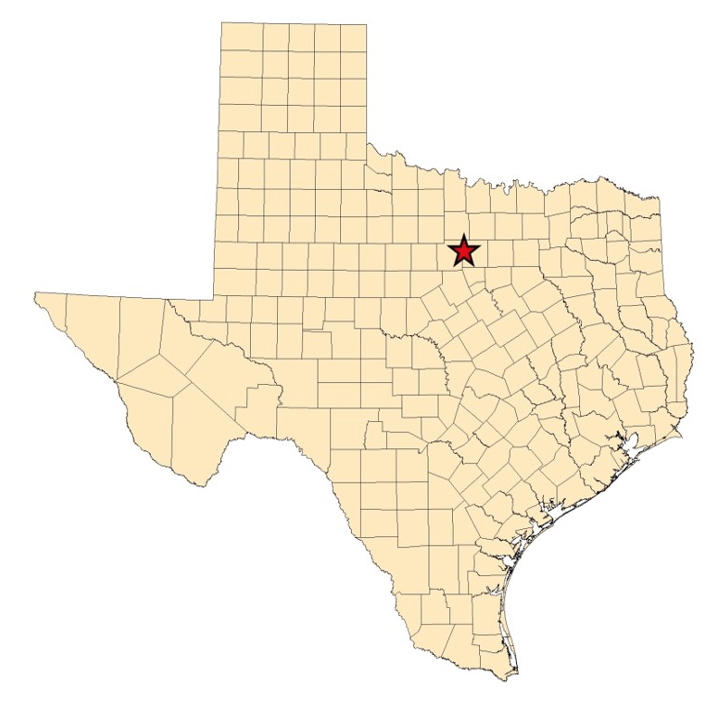
Work Session Item No. 14
Exhibit B
Vicinity Map for Lake Mineral Wells State Park (SP) and Trailway, 2 Miles East of Mineral Wells
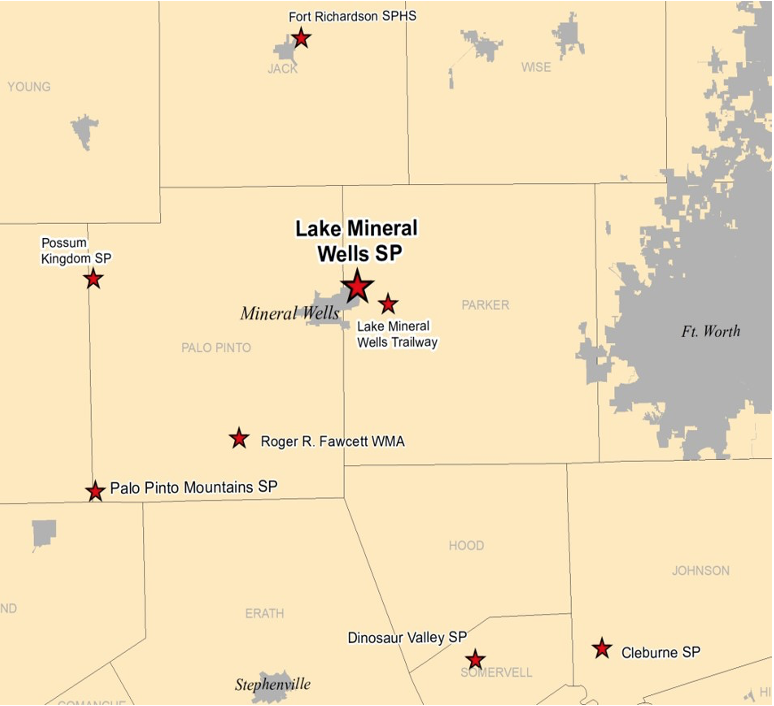
Work Session Item No. 14
Exhibit C
Map of Proposed Exchange
City of Mineral Wells Tracts to TPWD in Green
TPWD Tracts to the City of Mineral Wells in Yellow
City of Mineral Wells Property Outlined in Red
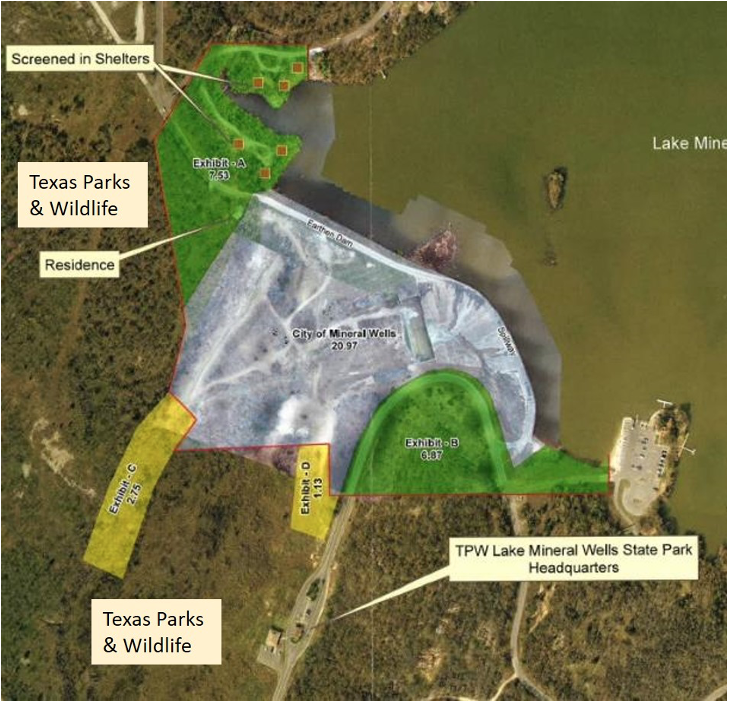
Work Session Item No. 15
Presenter: Trey Vick
Work Session
Exchange of Easements – Somervell County
Approximately 0.1 Acre at Dinosaur Valley State Park
Request Permission to Begin the Public Notice and Input Process
November 3, 2021
I. Executive Summary: Texas Parks and Wildlife Department (TPWD) needs an approximately 0.1-acre easement adjacent to Dinosaur Valley State Park (SP) to meet Texas Commission on Environmental Quality (TCEQ) requirements for the upgrade of an existing TPWD wastewater treatment facility. In exchange for such an easement, the adjacent landowner requests a short driveway easement.
II. Discussion: Dinosaur Valley SP opened in 1972 and comprises 1,587 acres in Somervell County southwest of the Dallas/Fort Worth Metroplex, near the city of Glen Rose. The park sits along the banks of the Paluxy River and is well known for the well-preserved dinosaur tracts found in the limestone riverbed of the Paluxy. Dinosaur Valley SP has been designated a National Natural Landmark by the National Park Service.
TPWD staff has been asked to negotiate a 0.1-acre non-development buffer easement from an adjacent private landowner to meet new requirements set forth by TCEQ for a wastewater treatment facility owned by TPWD. Initial conversations have started with the adjacent landowner, and in exchange for this easement, the private landowner is requesting a 30-foot-wide access easement across state land to a portion of his property.
The staff requests permission to begin the public notice and input process.
Attachments – 5
Work Session Item No. 15
Exhibit A
Location Map for Dinosaur Valley State Park in Somervell County
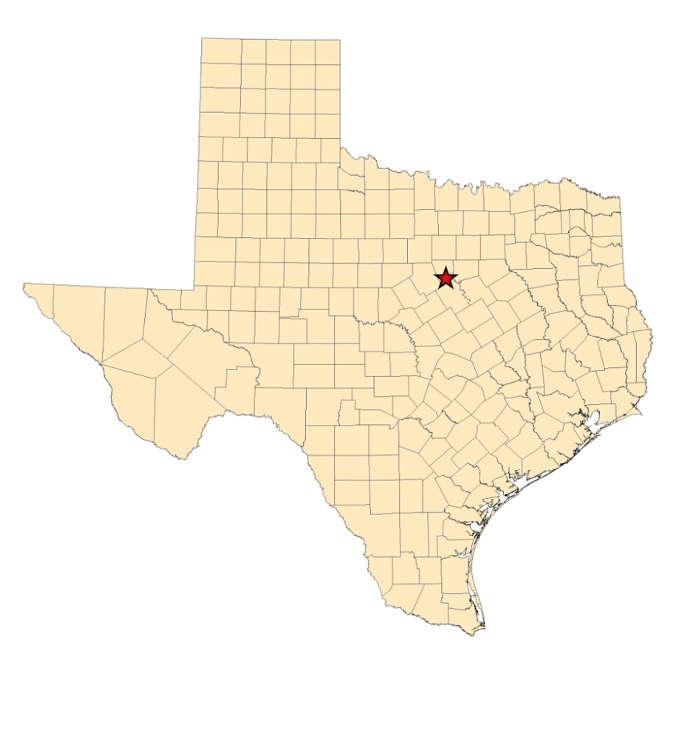
Work Session Item No. 15
Exhibit B
Vicinity Map for Dinosaur Valley State Park (SP), Glen Rose, TX
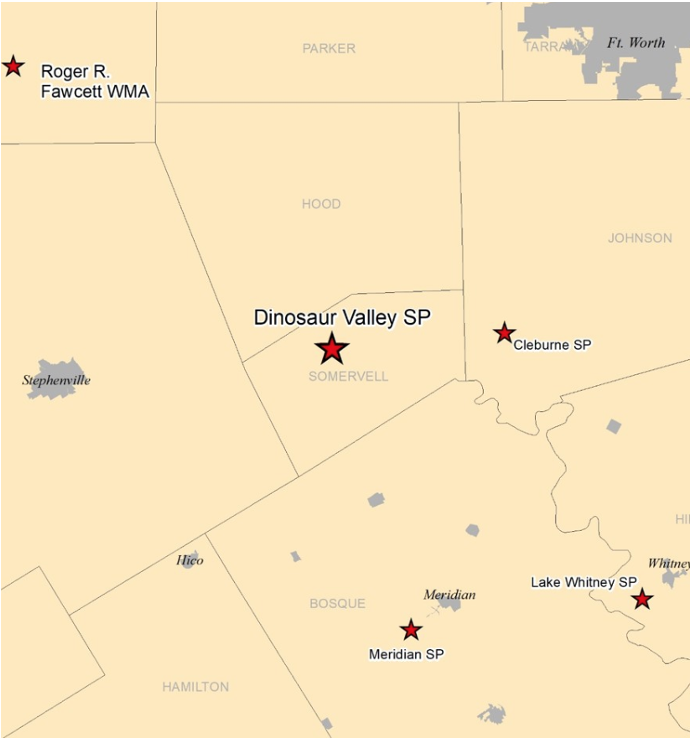
Work Session Item No. 15
Exhibit C
Location of Proposed Easement Exchange in Yellow Dinosaur Valley State Park Outlined in Red
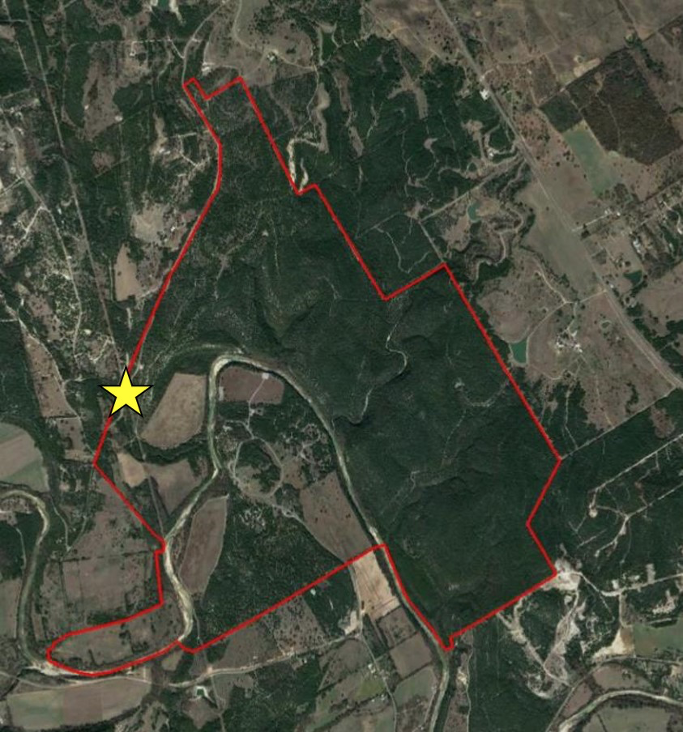
Work Session Item No. 15
Exhibit D
Location of Easement Exchange
TPWD Requested Easement in White
Landowner Requested Access Easement in Yellow
Wastewater Treatment Plant Outlined in Green
Dinosaur Valley State Park Outlined in Red
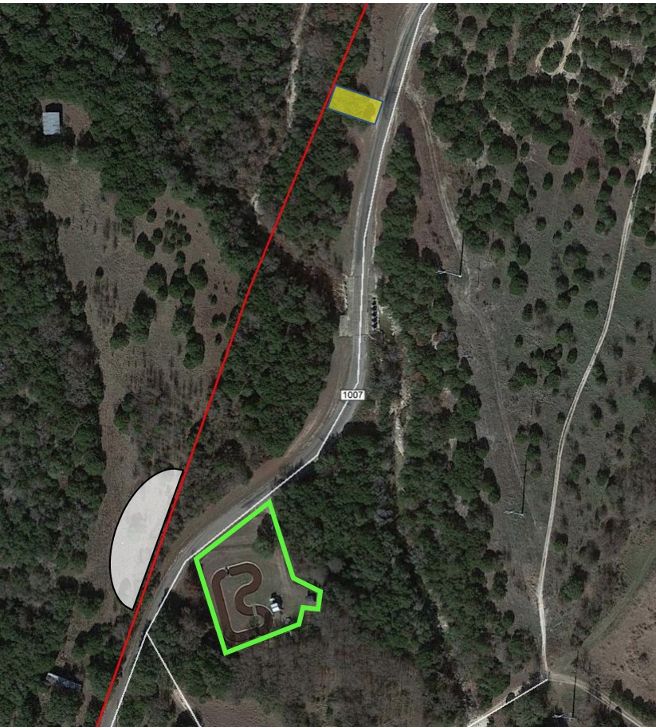
Work Session Item No. 15
Exhibit E
Buffer Easement Survey Plat
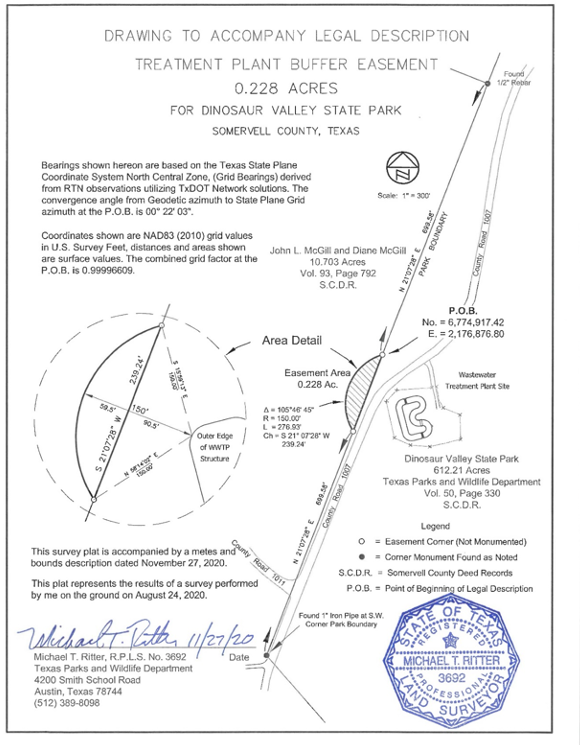
Work Session Item No. 16
Presenter: Ted Hollingsworth
Work Session
Request for Drainage Easement – Orange County
Approximately 20 Acres at the Lower Neches Wildlife Management Area
Request Permission to Begin the Public Notice and Input Process
November 3, 2021
I. Executive Summary: The Orange County Drainage District (OCDD) requests a pair of easements across the Old River and Nelda Stark Units of the Lower Neches Wildlife Management Area (WMA) to clean out, enlarge, and extend a system of stormwater drainage canals.
II. Discussion: The Lower Neches WMA consists of three units totaling approximately 6,600 owned acres and 1,437 leased acres adjacent to the Neches River near its confluence with Sabine Lake in Orange County. The habitat is made up almost exclusively of coastal wetlands including open water and natural and restored marshes, with small areas of transitional and upland habitat. The area is a popular destination for fishermen, waterfowl hunters, and nature watchers.
The WMA is bordered to the north by the community of Bridge City. Much of this community rests only a few feet above sea level and drains south into the WMA or into waters adjacent to the WMA. The OCDD believes the most effective way to reduce stormwater flooding is to re-profile the existing ditches and canals, excavate new canals to connect existing systems, and extend canals across emergent marshes within the WMA.
Texas Parks and Wildlife Department (TPWD) staff has been working with the OCDD to minimize the proposed taking of TPWD land and reduce potential impacts to fish and wildlife resources.
The staff requests permission to begin the public notice and input process.
Work Session Item No. 16
Exhibit A
Location Map for the Lower Neches Wildlife Management Area in Orange County
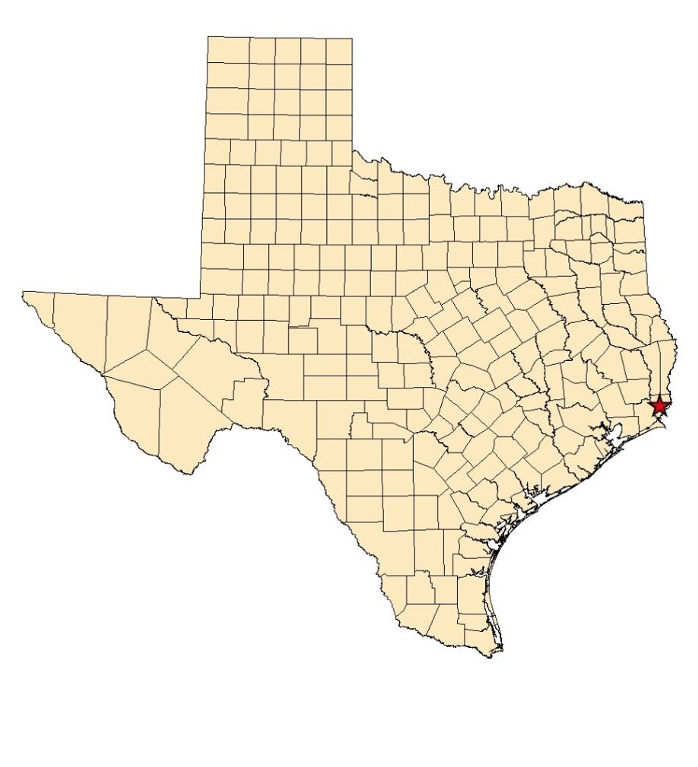
Work Session Item No. 16
Exhibit B
Vicinity Map for the Lower Neches Wildlife Management Area Between Nederland and Orange
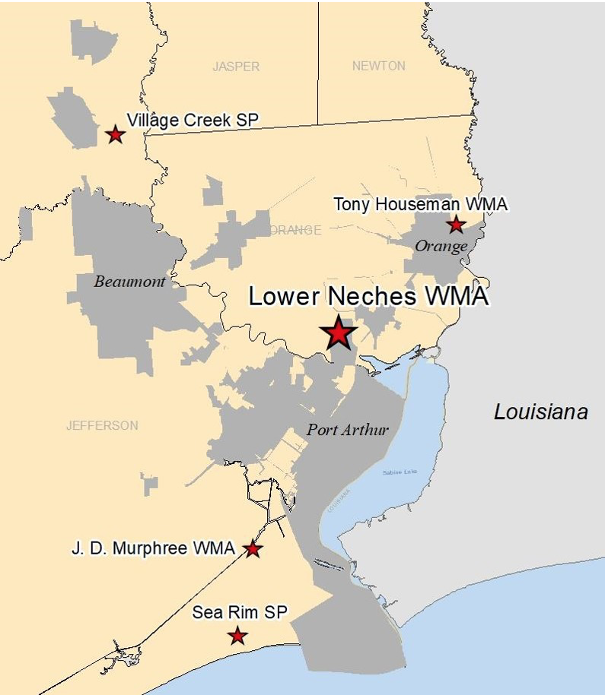
Work Session Item No. 16
Exhibit C
Site Map for Proposed Route Drainage Improvements on Lower Neches WMA Outline of Lower Neches Wildlife Management Area in Yellow Proposed Drainage Improvements in Blue
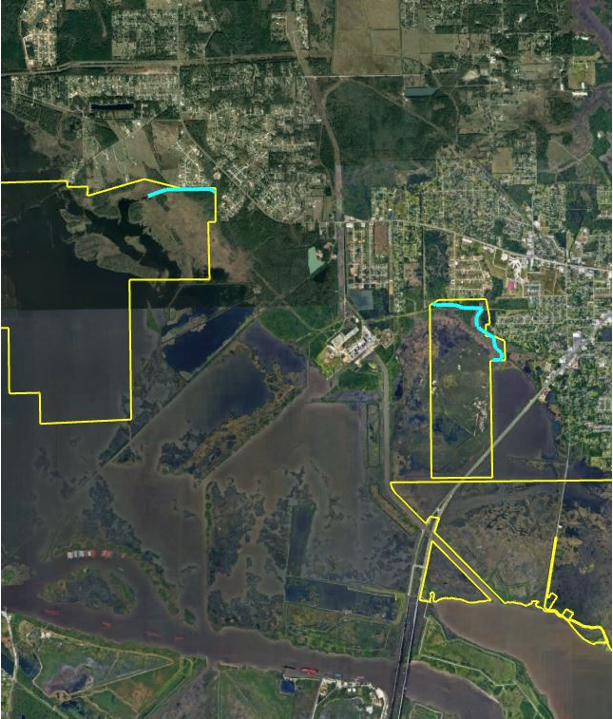
Work Session Item No. 17
Presenter: James Murphy
Executive Session Only
Litigation Update
November 3, 2021
I. Executive Summary: Attorneys for the Texas Parks and Wildlife Department (TPWD) will update and advise the Texas Parks and Wildlife Commission regarding pending or anticipated litigation, including but not limited to the following pending lawsuits:
- Potential or pending litigation related to oysters, including but not limited to State of Texas v. Chambers-Liberty Counties Navigation District, Each in his Official Capacity: Terry Haltom as CLCND Commissioner, Allen Herrington as CLCND Commissioner, Kenn Coleman as CLCND Commissioner, Ken Mitchell as CLCND Commissioner, and Dave Wilcox as CLCND Commissioner, and Sustainable Texas Oyster Resources Management, LLC., Cause No. D-1-GN-15-003093, in Travis County District Court.
- Potential or pending litigation regarding disease in white-tailed deer, including but not limited to:
- Rockstar Whitetails, LLC and Al Boenker IV v. Texas Parks and Wildlife Department, Texas Parks and Wildlife Commission and Carter Smith in his official capacity as the Executive Director of the Texas Parks and Wildlife Department, Cause No. D-1-GH-21-002994, in the 53rd Judicial District Court, Travis County, Texas; and
- Ken Bailey and Bradly Peterson v. Carter Smith, Executive Director, Clayton Wolf, Wildlife Division Director, Mitch Lockwood, Big Game Program Director and Texas Parks and Wildlife Department, Cause No. D-1-GN-15-004391, in Travis County District Court.
- Potential or pending litigation related to red snapper, including but not limited to State of Texas v. U.S. Department of Commerce, Civil Action No. 3:20-cv-00297, in United States District Court, Southern District of Texas, Galveston Division.
- Potential or pending litigation related to unauthorized disturbance of streambeds and permits required for marl, sand, gravel, shell, or mudshell, including but not limited to State of Texas v. Kenneth Berry, et al., Cause Number 4232, in the 452nd Judicial District Court of Edwards County, Texas.
- Potential or pending litigation related to conduct of employees, including but not limited to Ernest Trevino v. Texas Parks and Wildlife Department, Carter Smith, Derek Iden, Jon Brauchle, Mike Durand and Jonathan Gray, et al., Cause No. SA-17-CA-1133-OLG, in the United States District Court, Western District of Texas.
Work Session Item No. 18
Presenter: Chairman Arch “Beaver” Aplin, III
Executive Session Only
Personnel Matters
Performance Evaluation of the Texas Parks and Wildlife Department Executive Director
November 3, 2021
I. Executive Summary:
- Annual Performance Evaluation of the Texas Parks and Wildlife Department Executive Director